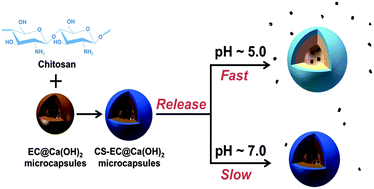Chitosan-decorated calcium hydroxide microcapsules with pH-triggered release for endodontic applications†
Abstract
The treatment of apical periodontitis (AP) remains challenging because traditional root canal therapy (RCT) outcomes are limited by the complexity of the root canal system, drug toxicity, and host immune factors. It is necessary to develop methods to prepare controlled drug release vehicles with improved biocompatibility for treatment of AP. Herein, calcium hydroxide microcapsules with chitosan and ethylcellulose coated (CS–EC@Ca(OH)2 microcapsules) were prepared and the presence of hydrogen bonding between shell materials was observed by FT-IR. Through release assessment and biological assays, we showed that the microcapsules had enhanced controlled-release performance and biocompatibility. In particular, drug release from the microcapsules was pH-triggered. The cumulative release of drugs in pH 5.0 buffer was 8-fold higher than that in pH 7.0 buffer. Furthermore, the microcapsules exhibited prolonged antibacterial activity against refractory strains of Enterococcus faecalis. Additionally, the CS–EC@Ca(OH)2 microcapsules reduced inflammation and promoted osteogenesis, which could be beneficial for the healing of AP with bone defects. Therefore, CS–EC@Ca(OH)2 microcapsules improve the innate properties of Ca(OH)2 and hold potential for AP treatment.


 Please wait while we load your content...
Please wait while we load your content...